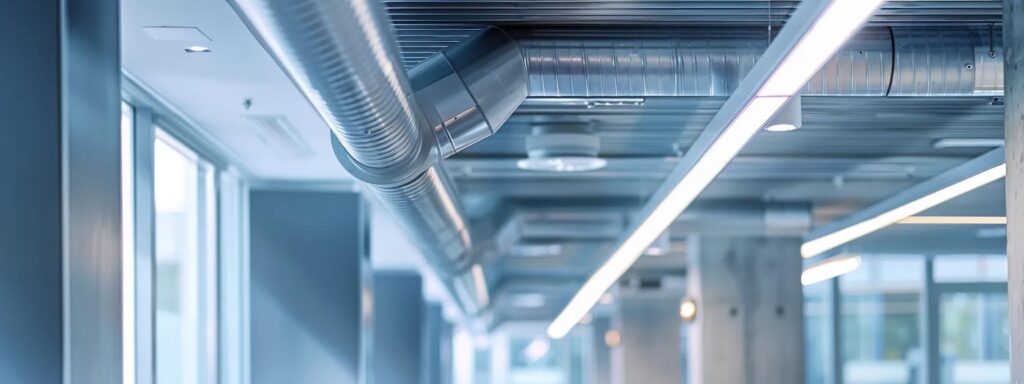Prioritizing Duct Health to Keep Mold at Bay

Duct Health: Avoid Mold Build Up
Maintaining clean and healthy air ducts, including furnaces, is essential to preventing mold and ensuring optimal indoor air quality. Homeowners need to be aware of potential mold growth sources in their air ducts and how regular HVAC maintenance and maintenance plans can help protect their home’s comfort and safe living environment. If concerns arise, it’s always wise to request estimate for further assistance.
Identify Common Sources of Mold in Air Ducts for Prevention
Mold growth in air ducts is primarily driven by moisture and inadequate maintenance. Common sources include condensation, infiltration of outdoor water, and internal leaks. This section outlines the critical contributors to mold in air ducts.
Recognize Moisture Buildup and Its Consequences for Ducts
Moisture in ducts creates a favorable environment for mold spores. When warm, humid air cools within the ductwork, condensation forms on surfaces and encourages microbial growth. Over time, this leads to deterioration of insulation and metal components while degrading indoor air quality through the release of spores and volatile organic compounds (VOCs) that may trigger allergies and respiratory problems.
Understand the Impact of Dust and Debris on Mold Growth
Dust and debris act as nutrients for mold. As particulate matter accumulates, it traps moisture and creates layers that foster microbial colonies. Regular duct cleaning and quality air filtration can reduce this risk by limiting the available food source and maintaining proper airflow.
Investigate Leaks in Ductwork and Sealing Options
Leaks in the duct system allow humid air to condense on cooler surfaces, contributing to mold proliferation. It is important to identify and repair gaps or cracks. Professional inspections and the use of sealants and mastic compounds can effectively seal joints and block moisture entry.
Assess HVAC System Components and Their Role in Humidity
Components such as cooling coils, evaporators, and condensers can generate excess moisture when faulty or inefficient. Upgrading to energy-efficient, well-maintained HVAC units minimizes excess humidity and supports a healthier indoor climate.
Detect Poor Ventilation Practices That Contribute to Mold
Improper airflow allows stagnant, moist air to accumulate. Blocked vents, undersized ductwork, or poorly designed systems can all contribute to this problem. Routine assessments of the ventilation system help reduce moisture buildup and improve overall air quality.
Analyze Insulation Materials for Potential Moisture Retention
Certain insulation materials may retain moisture, providing a substrate for mold growth. Fiberglass and low-quality foam insulation, when wet, lose effectiveness and support mold colonization. Upgrading to moisture-resistant insulation and ensuring proper installation techniques are key to preventing mold proliferation.
Implement Routine Maintenance to Protect Duct Health

Routine maintenance helps control mold development and preserves duct integrity. Regular service schedules can prevent mold and reduce repair costs over time. The following steps offer guidance for maintaining clean, efficient, and safe air ducts.
Establish a Regular Cleaning Schedule for Air Ducts
A consistent cleaning schedule is necessary to remove dust, debris, and microbial contaminants. Experts recommend cleaning ducts every 3 to 5 years, with more frequent cleaning for homes with pets, smokers, or high humidity. Regular cleaning reduces the buildup of particulates that encourage mold formation.
Utilize Professional Services for Deep Duct Cleaning
Certified professionals use specialized equipment to sanitize ducts, registers, and vents thoroughly. Deep cleaning reaches bends and difficult areas, dramatically reducing the likelihood of hidden mold growth.
Change Air Filters Consistently to Improve Air Quality
Air filters trap dust and particulates, reducing the “food supply” for mold. Regular replacement of filters—ideally high-efficiency HEPA or high MERV-rated ones—improves indoor air quality and helps prevent mold buildup.
Monitor Humidity Levels With Suitable Devices
Maintaining a relative humidity below 50% is key to hindering mold growth. Using hygrometers to track moisture levels near ductwork can alert homeowners to potential issues before mold can develop.
Inspect and Maintain HVAC Systems Regularly
Routine HVAC inspections ensure that components function optimally while reducing leaks, condensation, and other moisture-related issues. Regular checks and timely repairs support a healthy duct system and help prevent mold growth.
Seal and Insulate Ducts Adequately to Prevent Moisture
Properly sealing and insulating ductwork prevents moisture ingress and condensation. Professional sealing and the use of moisture-resistant materials not only boost system efficiency but also protect against mold even in humid environments.
Utilize Dehumidifiers to Control Moisture in Your Home
Dehumidifiers lower indoor humidity levels, thus mitigating mold growth in ducts. By maintaining the right moisture balance, these devices support overall system health and create an environment less hospitable to mold spores.
Select the Right Dehumidifier for Your Living Space
Choose a dehumidifier based on the area’s size and moisture challenges. Compact units suit single rooms, while larger systems cover entire homes. Energy efficiency and appropriate run times are important for optimal performance and cost-effectiveness.
Place Dehumidifiers Strategically for Maximum Effectiveness
Place dehumidifiers near ductwork, basements, or areas with limited airflow to capture condensation before it settles. Strategic placement enhances their moisture removal effectiveness.
Understand Ideal Humidity Levels for Mold Prevention
Maintaining relative humidity between 30% and 50% discourages mold spore germination. Digital humidity monitors or smart devices can provide continuous feedback, enabling precise adjustments to dehumidifier settings.
Maintain and Clean Dehumidifiers to Ensure Efficiency
Regular maintenance—cleaning filters and water trays—ensures dehumidifiers operate at peak efficiency. An appliance free of buildup helps prevent moisture accumulation near ducts and throughout the home.
Integrate Dehumidification With HVAC Systems
Modern HVAC units may integrate dehumidification features. Using these modes or additional controls allows for better management of indoor humidity and supports overall duct health.
Monitor and Adjust Settings Based on Seasonal Changes
Indoor humidity levels can vary with the seasons. Adjust dehumidifier settings during warmer, more humid months, and review them periodically to ensure ducts remain dry and free from mold.
Enhance Ventilation to Minimize Mold Risks

Improving ventilation reduces indoor moisture and prevents mold proliferation in ductwork. Better air circulation not only freshens the home but also supports efficient HVAC operation by promoting even heat distribution and moisture control.
Open Windows to Allow Fresh Air Circulation Regularly
Regularly opening windows promotes air exchange and reduces moisture buildup. Fresh air dilutes indoor pollutants and moisture, lowering the risk of condensation on duct surfaces.
Install Exhaust Fans in Moisture-Prone Areas
Exhaust fans remove humid air from kitchens, bathrooms, and laundry rooms. They create negative pressure that directs moist air outdoors, reducing the chance of nearby duct contamination.
Assess Natural Ventilation Effectiveness in Your Home
Evaluate your home’s natural ventilation by observing airflow patterns and identifying stagnant areas. Simple upgrades like installing trickle vents or adjustable louvers can significantly enhance overall ventilation.
Utilize Ceiling Fans for Improved Air Movement
Ceiling fans provide a cost-effective way to improve indoor air circulation. They help distribute temperature evenly and reduce moisture on surfaces, thereby supporting duct efficiency.
Ensure Proper Airflow Around HVAC Units and Ducts
Maintain clear space around HVAC units and ductwork. Removing obstructions and clutter ensures proper airflow, reducing moisture retention and the likelihood of mold growth.
Evaluate Ventilation Systems for Upgrades or Repairs
Periodically assess your ventilation systems, especially in older homes. Upgrading outdated systems or investing in repairs can reduce indoor humidity and help prevent mold proliferation.
Educate Yourself on Mold Types and Their Impact
Understanding mold and its health impacts is crucial for proactive duct maintenance. Being informed enables homeowners to quickly recognize symptoms and take preventive measures.
Examine the Health Effects of Different Mold Types
Different mold species present various health risks. Some release mycotoxins that affect the respiratory system, trigger allergies, or worsen conditions like asthma. Awareness of these risks is necessary for early detection and remediation.
Learn to Identify Visible Mold and Its Indicators
Visible signs such as discoloration, a musty odor, or slimy residues indicate mold presence. Accessing online guides and professional assessments can help homeowners identify these indicators early.
Conduct Regular Home Inspections for Mold Presence
Routine home inspections, especially after heavy rain or during humid periods, are key to early mold detection. Documenting these inspections can help track any issues and prompt timely remediation before they worsen.
Understand the Life Cycle of Mold and Prevention Tactics
Knowing mold’s life cycle—from spore germination to colony growth—enables targeted preventive measures. Quickly reducing moisture after water damage can stop mold spores from developing into full-blown colonies.
Stay Informed About Local Climate Effects on Mold Growth
Local weather, such as high humidity or seasonal rain, influences mold activity. Adjusting indoor maintenance practices based on local climate conditions can support proactive duct health management.
Research Safe Mold Removal Methods and Practices
When mold is detected, safe removal methods are essential. Techniques include the use of anti-fungal solutions, HEPA air scrubbers, and proper PPE. For severe infestations, hiring certified mold remediation professionals is advisable to ensure effective and safe removal.
Take Prompt Action if Mold Is Detected in Ducts

Immediate intervention is critical when mold is found in ducts. Delays can lead to more extensive contamination, increased energy usage, and health complications.
Follow Proper Safety Protocols When Addressing Mold
When addressing mold, always adhere to safety protocols. Wearing N95 respirators, gloves, and protective eyewear helps minimize exposure. Isolating affected areas can further prevent the spread of contaminants.
Hire Certified Professionals for Effective Mold Remediation
Certified mold remediation experts have the necessary tools and expertise for thorough duct cleaning and safe mold removal. Their use of industrial-grade cleaning processes reduces the risk of incomplete removal and cross-contamination.
Document Mold Issues and Responses for Records
Keep detailed records of any mold incidents, including photographs, inspection reports, and remediation invoices. These documents help track remediation success and serve as evidence for possible insurance claims or property disputes.
Notify Home Occupants or Tenants About Mold Risks
Inform all occupants or tenants about any mold issues and planned remediation efforts. Transparency helps ensure that everyone takes appropriate precautions and contributes to maintaining a healthy living environment.
Institute Preventive Measures Post-Removal for Assurance
After remediation, implement preventive measures such as more frequent duct cleaning, addressing persistent moisture, and upgrading insulation and seals. Continued HVAC inspections and humidity monitoring support long-term mold prevention.
Assess the Need for Duct Replacement or Major Repairs
If ductwork is extensively damaged or mold issues recur despite regular cleaning, replacement or major repairs may be necessary. An evaluation by HVAC professionals can determine the most cost-effective long-term solution.
Frequently Asked Questions
Q: How can regular duct cleaning help prevent mold buildup? A: Regular duct cleaning removes dust, debris, and moisture that provide an ideal environment for mold spore growth, thus lowering the risk of mold development.
Q: What are the signs that my air ducts might have a mold problem? A: Signs include a musty odor, visible discoloration on duct surfaces, reduced airflow, and unexpected spikes in indoor humidity. These issues warrant professional inspection.
Q: How often should air ducts be cleaned to maintain optimal health? A: Most experts suggest cleaning air ducts every 3 to 5 years, though homes with pets, smokers, or high humidity may require more frequent cleaning.
Q: Can I use a dehumidifier to prevent mold in my ducts? A: Yes, using a dehumidifier to keep indoor relative humidity between 30% and 50% helps prevent moisture accumulation and discourages mold growth.
Q: What type of insulation is most effective at preventing moisture retention and mold growth in ducts? A: Moisture-resistant insulation materials—such as foil-faced or spray foam insulation—are most effective because they reduce condensation and protect against mold proliferation.
Q: Why is proper ventilation important in controlling mold growth in HVAC systems? A: Proper ventilation ensures continuous air circulation, reducing stagnant moisture and preventing condensation on duct surfaces, which minimizes mold growth.
Q: When should I consider replacing my ductwork instead of cleaning it? A: If ductwork is severely corroded, damaged, or repeatedly affected by mold even after cleaning and repairs, replacement may be more effective for maintaining indoor air quality.
Q: How does improved HVAC maintenance contribute to mold prevention? A: Regular HVAC maintenance ensures that all components operate efficiently by reducing moisture generation, maintaining proper airflow, and detecting issues early, all of which help lower the risk of mold development.
Final Thoughts
Regular maintenance and prompt action are critical for preventing mold in air ducts and ensuring a healthy indoor environment. Routine cleaning, effective humidity control, and proper ventilation can significantly reduce the risk of mold contamination. By understanding moisture sources and monitoring HVAC components, homeowners protect their investment in home comfort while safeguarding health. Consistent professional upkeep combined with proactive measures creates a long-term defense against mold, ensuring efficient system performance and a safe living atmosphere.